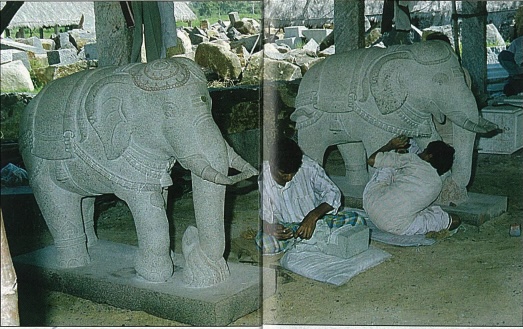The great works of saints live on long after their passing.” This time-worn adage consoles devotees when their beloved guru passes. But in Kanchi, devotees of the late Sri Chandrasekharendra Saraswati Swamigal are not content with consolation. Members of the Mahalakshmi Mathrubhutheswarar Trust, with the blessings of successor Sri Jayendra Saraswati, have dedicated themselves to giving this maxim maximum meaning.
They state, “The Trust has as its immediate goal the construction of the Satabdi Mani Mantapam in Orirukkai village, near Kancheepuram, on the northern bank of the river Palar. It will be an all-granite marvel in sculpture, providing a visual running commentary of the times and achievements of our adorable Maha Periyaval.” The Mantapam is a guru-temple for all who were touched by Chandrasekharendra, who passed in 1994 at age 99. “It will be an abode, a retreat and a refuge for all seekers,” says K. Vedamurthy, a trustee.
The Mantapam will also preserve the cultural and historical heritage of the Kanchi Matha and each of the 70 acharyas who have reigned there since its founding by Adi Sankara. An image of each acharya will be installed, including his name, period and details of his life. However, the plans to collect materials pertaining to Chandrasekharendra’s life are far more extensive. The trust has published an appeal in print and on the Internet for devotees who have any photos or stories relating to the Acharya to send them to the trust for inclusion in the Mantapam archives and displays. Stories of magical and spiritual experiences are already flooding in. Selections may even be carved into the temple stones as a permanent feature of the temple.
In honor of Chandrasekharendra’s emphatic love of the Vedas, the Trust also envisions the Mantapam to be a hub for researchers and scholars of Vedic culture, where they may come together to study, review the past and anticipate the future.
Construction began on June 9, 1997, and today an average of 75 silpis (sculptors) and 15 assistants daily bring the temple closer to completion. The structure is divided (architecturally) into four sections: the paduka, prahara, praja and maha mandapams. The maha mandapam will have 151 granite pillars, each depicting scenes from Chandrasekharendra’s life. The trustees are hopeful for completion at the end of five years, with expectations that it might stretch to eight.
High quality granite was easily acquired through a bit of divine circumstance. The Ramakrishna Matha had accumulated a virtual mountain of granite blocks in preparation for their construction of the Universal Temple in Chennai. But the Matha switched to brick and mortar in order to complete the temple sooner, thus freeing all the granite. The MM Trust then moved in, purchased all the stone and trucked it to Orirukkai.
The temple was designed and is being executed by Thiru S.M. Ganapathi Sthapati, a renowned and accomplished sculptor. Sthapati explains, “The Acharya would talk often about the contribution of the Pallavas, Cholas and Nayakas, and so I have incorporated all three architectural styles here.” The main sanctum, paduka mandapam, will hold a pair of the Acharya’s paduka, sacred sandals, making the Mani Mantapam a unique temple to this guru and his works, created for and by his devotees.
Satabdhi Mani Mandapam Trust, “Sivam-Subham,”
11 First Main Road, Kotturpuram, Chennai
600 085 india. tel: 91.44.491.1229
fax: 91.44.491.0740.
www.bayindia.com/sankara;
e-mail: rind@vsnl.com


